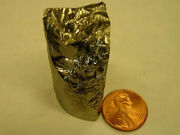In all the excitement over Intel and IBM breaking through the 45 nm barrier, important facts are being ignored.
First, the breakthrough does mean the end of Moore’s Law, in the sense Gordon Moore originally expressed it, and wanted it to be understood. Getting to 45 nanometers between circuit lines required the creation of a new type of material, dubbed High K.
The reason for the cute acronym? The new substance is based on hafnium, an element similar to zirconium that is also used to make control rods for nuclear reactors, because it absorbs neutrons so readily. It’s not simple stuff and it’s not cheap. Remember all those old commercials talking about how computer chips were made of sand? No more.
But the use of hafnium also brings up another important point, an
outgrowth of Moore’s Second Law that the industry, and society,
continue to ignore. (Image from Luuluu, a Chinese Flickr user.)
Moore’s Second Law, for those who don’t know, is that as circuit lines
grow closer the development costs increase geometrically. These come
out through mass production, but they also squeeze out competition in
basic processes. That’s why there are so few real chip companies —
most are "fab-less" designers of chips who ship those designs out to
foundries for production.
But that’s just the financial cost. There is also an environmental cost
to chip production, a high one. The acids and other chemicals used to
finish goods throughout the process are nasty. The addition of hafnium
to the mix just makes it that much worse.
It’s these environmental costs that sent the U.S. chip industry
overseas in the first place. Even 20 years ago it was impossible to
both pay those costs here and to compete with countries that declined
to pay them. Those costs are being hidden right now in China, and they
must be paid in time, in the form of birth defects, dead zones or in
hyper-expensive clean-up operations.
Thus we have Moore’s Third Law. The more complex chips get, the worse they get for the environment.
Eventually, hopefully soon, the Chinese government and the other
governments who have been lured into chip production will get the
message, and demand those costs be paid. This will have two beneficial
impacts. It will mean a clean-up, sure, but it could also lure plants
back to North America, so we won’t be subject to Chinese chip blackmail
in the next decade as we’ve been subject to Arab oil blackmail in this
decade.
Hopefully, at that time, someone will use The Google and find this piece. I told you so.












Because we have had computer technology advancing for most of a human lifetime, we forget that all technology has a curve of “diminishing returns”. At one time, gasoline-powered vehicles were following a Moore’s “law” type progression – every few years, they doubled in speed. If this progression had continued, our cars should be supersonic.
Unfortunately, Moore’s law has turned from an empirical curve-fitting into a religion. These days, you read articles about companies “upholding Moore’s Law” by creating faster computers – as if failue to do so violated a law of nature, like gravity. Techno-optimists show a kind of religion-inspired magical thinking. They want computers to get faster, so they insist that it they will.
Computers are particularly good at inspiring this kind of uncritical faith since they create virtual dream worlds in which anything can happen – hey, if I can jump 1000 feet in playing my playstation, why can’t “they” do the same for computers?
It will be interesting to see the faith of Engadget-hounds in endless “accelerating change” and an endless supply of gadgets as it becomes increasingly threated by the real world.
Because we have had computer technology advancing for most of a human lifetime, we forget that all technology has a curve of “diminishing returns”. At one time, gasoline-powered vehicles were following a Moore’s “law” type progression – every few years, they doubled in speed. If this progression had continued, our cars should be supersonic.
Unfortunately, Moore’s law has turned from an empirical curve-fitting into a religion. These days, you read articles about companies “upholding Moore’s Law” by creating faster computers – as if failue to do so violated a law of nature, like gravity. Techno-optimists show a kind of religion-inspired magical thinking. They want computers to get faster, so they insist that it they will.
Computers are particularly good at inspiring this kind of uncritical faith since they create virtual dream worlds in which anything can happen – hey, if I can jump 1000 feet in playing my playstation, why can’t “they” do the same for computers?
It will be interesting to see the faith of Engadget-hounds in endless “accelerating change” and an endless supply of gadgets as it becomes increasingly threated by the real world.
It’s these environmental costs that sent the U.S. chip industry overseas in the first place. Even 20 years ago it was impossible to both pay those costs here and to compete with countries that declined to pay them. Those costs are being hidden right now in China, and they must be paid in time, in the form of birth defects, dead zones or in hyper-expensive clean-up operations.
What a bunch of misinformed nonsense. IBM has a large semiconductor factory in East Fishkill NY, Intel has several factories in the USA including Oregon, AMD has factories in Germany. AMD does however package chips in Malaysia, it is a hand labor intensive process, people work for less there.
Yes the manufacturing process uses acids to dissolve the layer after lithography. It used to be these were dumped. Not anymore. The industry is pursuing other solvents as well.
It’s these environmental costs that sent the U.S. chip industry overseas in the first place. Even 20 years ago it was impossible to both pay those costs here and to compete with countries that declined to pay them. Those costs are being hidden right now in China, and they must be paid in time, in the form of birth defects, dead zones or in hyper-expensive clean-up operations.
What a bunch of misinformed nonsense. IBM has a large semiconductor factory in East Fishkill NY, Intel has several factories in the USA including Oregon, AMD has factories in Germany. AMD does however package chips in Malaysia, it is a hand labor intensive process, people work for less there.
Yes the manufacturing process uses acids to dissolve the layer after lithography. It used to be these were dumped. Not anymore. The industry is pursuing other solvents as well.